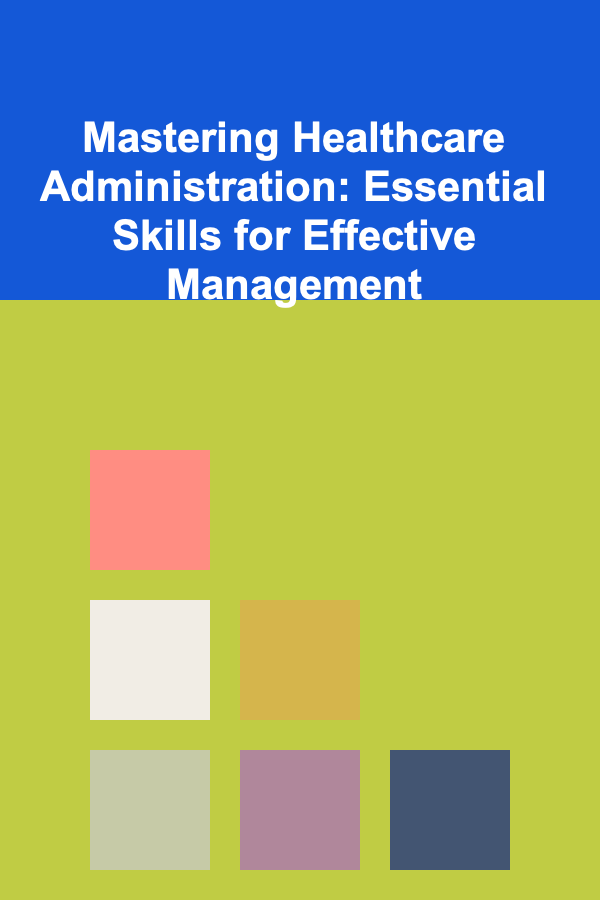
Mastering Healthcare Administration: Essential Skills for Effective Management
ebook include PDF & Audio bundle (Micro Guide)
$12.99$8.99
Limited Time Offer! Order within the next:

Healthcare administration is an essential pillar in the healthcare system, encompassing the management of medical facilities, the strategic direction of healthcare delivery, and the continuous improvement of patient care services. The role of healthcare administrators has evolved significantly in recent years due to factors such as technological advancements, regulatory changes, and the increasing complexity of patient needs. As such, mastering healthcare administration is not only about managing the day-to-day operations of healthcare institutions but also ensuring that these systems are efficient, responsive, and patient-centric.
This guide focuses on the critical skills healthcare administrators need to master in order to effectively manage healthcare organizations and improve the overall healthcare delivery system. By enhancing leadership abilities, mastering operational management, and focusing on patient-centered care, healthcare administrators can steer their organizations toward success.
Leadership: Guiding Teams and Shaping the Organization's Future
Effective leadership is a cornerstone of successful healthcare administration. Healthcare administrators must act as visionaries and strategic leaders while ensuring that their actions align with the organizational mission and core values. Leadership in healthcare is about more than just managing teams---it's about inspiring change, making tough decisions, and cultivating a culture that fosters collaboration, growth, and compassion.
Visionary Leadership
Visionary leadership in healthcare requires administrators to not only manage current operations but also anticipate future challenges and opportunities. A clear vision enables administrators to steer healthcare organizations through periods of change, such as adapting to new technology, evolving healthcare policies, and shifting patient demographics.
Actionable Steps:
- Articulate a Clear Vision: Craft a long-term strategic vision that defines the future direction of the organization. This vision should be communicated consistently across all levels of the organization to ensure alignment and engagement.
- Anticipate Healthcare Trends: Stay ahead of industry trends and be prepared for the future by understanding emerging healthcare technologies, regulatory changes, and patient expectations. Proactively adapt the organization's practices to meet these shifts.
Communication and Team Building
In a healthcare setting, clear and open communication is crucial for achieving positive outcomes. Healthcare administrators must establish channels for open dialogue and foster an environment of trust and respect within their teams. Effective communication is essential not just with medical staff but with all stakeholders, including patients, families, and other healthcare professionals.
Actionable Steps:
- Establish Open Channels: Implement systems for regular communication, such as weekly meetings, open-door policies, or digital platforms, where staff can provide feedback and share ideas.
- Build Cross-Disciplinary Teams: Promote teamwork by establishing cross-functional teams that bring together diverse skill sets to solve problems and innovate within the healthcare system.
- Model Transparency: Practice transparency in decision-making and be open to feedback. This builds trust within the organization and creates an environment where staff feel empowered to share concerns and propose solutions.
Decision-Making and Problem-Solving
Healthcare administrators often face complex situations that require quick, informed decision-making. They must balance competing priorities---such as patient care, financial constraints, and staffing issues---while navigating the nuances of healthcare regulations and industry standards. Successful healthcare leaders are adept at making data-driven decisions that prioritize patient safety and organizational sustainability.
Actionable Steps:
- Use Data to Drive Decisions: Leverage healthcare data, such as patient outcomes, financial reports, and performance metrics, to inform decisions. Administrators should also be familiar with analytical tools that enable them to assess various outcomes before implementing changes.
- Practice Critical Thinking: Apply a critical thinking approach to problem-solving by considering multiple perspectives and potential consequences before making decisions. Engaging with team members to explore solutions can lead to more innovative and effective strategies.
- Develop a Risk Management Plan: Address potential risks proactively by identifying issues that could impact patient care or organizational performance. Create contingency plans for crises such as budget shortfalls, staff shortages, or public health emergencies.
Operational Excellence: Streamlining Systems for Optimal Performance
Effective healthcare administration is grounded in operational efficiency. Healthcare administrators must understand the ins and outs of healthcare operations, from financial management to staffing and supply chain logistics. Streamlining processes, improving resource allocation, and driving continuous improvement are key to delivering high-quality care while maintaining fiscal responsibility.
Financial Management
Financial management is one of the most critical aspects of healthcare administration. Healthcare facilities face the challenge of balancing financial sustainability with the provision of high-quality care. Administrators need to oversee budgets, allocate resources efficiently, and find ways to control costs without compromising patient care.
Actionable Steps:
- Establish a Robust Budgeting Process: Develop a comprehensive budget that outlines expected revenues and expenditures. Regularly review financial performance and adjust budgets to ensure resources are being allocated effectively.
- Monitor Cash Flow and Revenue Cycle: Keep track of cash flow and ensure that billing and reimbursement processes are efficient. Delays in payments and billing errors can create financial instability, which may hinder patient care.
- Explore Cost-Containment Opportunities: Look for areas where cost savings can be realized, such as reducing waste in medical supplies or optimizing staff schedules to reduce overtime costs. Small improvements in efficiency can result in significant savings.
Technology Integration and Health IT
The integration of technology into healthcare operations is no longer optional---it is essential for efficiency and quality. Healthcare administrators must champion the use of electronic health records (EHRs), telemedicine platforms, data analytics, and other technologies to enhance patient care, improve operational efficiency, and ensure compliance with healthcare regulations.
Actionable Steps:
- Invest in EHR Systems: Implement electronic health records to streamline patient information management, reduce medical errors, and ensure that clinicians have access to up-to-date patient data at the point of care.
- Leverage Data Analytics: Use data analytics to identify inefficiencies, predict patient needs, and improve clinical outcomes. Data-driven decision-making can help administrators optimize staffing levels, improve patient flow, and reduce wait times.
- Embrace Telehealth: Explore telemedicine options to increase access to care, particularly for patients in underserved areas or those with limited mobility. Telehealth has the potential to reduce costs and improve patient satisfaction by offering remote consultations.
Process Improvement and Lean Management
Healthcare administrators must consistently identify and eliminate inefficiencies in care delivery. Implementing process improvement methodologies such as Lean management can help streamline operations, reduce waste, and enhance patient outcomes.
Actionable Steps:
- Conduct Process Mapping: Use process mapping techniques to visualize workflows and identify bottlenecks or redundant steps in the patient care process. This will help streamline operations and improve patient flow.
- Implement Lean Practices: Apply Lean principles to eliminate waste in processes, reduce waiting times, and ensure that every step in the care delivery process adds value to the patient experience.
- Engage Staff in Continuous Improvement: Involve healthcare staff in continuous improvement initiatives. By fostering a culture of innovation, administrators can identify opportunities to enhance care and efficiency while maintaining staff engagement.
Patient-Centered Care: Placing the Patient at the Heart of Healthcare
At the core of every healthcare administration strategy should be a commitment to patient-centered care. Administrators must focus not just on the quality of medical services but also on the experience and outcomes for the patient. Ensuring that the healthcare system is accessible, compassionate, and responsive to the needs of patients is essential for building trust and delivering high-quality care.
Compassionate Care and Cultural Competence
Compassionate care is fundamental to patient-centered care. Administrators must create an environment where patients feel heard, respected, and supported throughout their healthcare journey. This includes training staff on effective communication, cultural sensitivity, and understanding the diverse needs of the patient population.
Actionable Steps:
- Train Staff on Empathy and Cultural Competence: Provide ongoing training to healthcare professionals on effective communication, empathy, and cultural sensitivity. Understanding the diverse backgrounds of patients can help foster trust and improve patient satisfaction.
- Ensure Respect for Patient Preferences: Encourage staff to engage with patients about their preferences and values when it comes to treatment plans. Informed consent and respect for autonomy should be central tenets of care delivery.
- Create a Healing Environment: Design patient care areas that promote comfort and relaxation. A compassionate, supportive environment can contribute to faster recovery and greater patient satisfaction.
Patient Feedback and Satisfaction
Monitoring patient satisfaction is an essential part of improving care quality. Administrators should have systems in place to regularly collect feedback from patients and use this data to inform decision-making.
Actionable Steps:
- Conduct Patient Satisfaction Surveys: Regularly distribute patient satisfaction surveys to collect feedback on various aspects of care, such as staff interactions, wait times, and treatment effectiveness.
- Analyze and Act on Feedback: Review patient feedback systematically and use it to implement improvements. Address recurring issues and involve staff in brainstorming solutions to enhance patient experience.
- Foster Patient Advocacy: Ensure that patients have access to advocates or support services that can help them navigate the healthcare system and voice their concerns.
Conclusion: The Future of Healthcare Administration
Mastering healthcare administration is an ongoing process that requires healthcare leaders to be adaptive, forward-thinking, and committed to continuous improvement. By cultivating strong leadership, refining operational practices, and prioritizing patient-centered care, healthcare administrators can build organizations that thrive in the face of ongoing challenges. These efforts ultimately lead to better patient outcomes, improved staff satisfaction, and a more efficient and sustainable healthcare system.
The future of healthcare administration will continue to be shaped by advances in technology, regulatory changes, and evolving patient needs. To succeed in this ever-changing landscape, healthcare administrators must remain adaptable, leverage data-driven decision-making, and foster a culture of compassion and excellence.

How To Build a Powerful Brand Story
Read More
How to Create a DIY Charcuterie Board for Your Home Party
Read More
How to Create a Passive Income Stream from Real Estate Investment
Read More
How to Make Sure Your Home Security System Is Always Updated
Read More
How to Plan for a Debt-Free Future and Stay on Track
Read More
How to Use ETFs (Exchange-Traded Funds) for Smart Investing
Read MoreOther Products

How To Build a Powerful Brand Story
Read More
How to Create a DIY Charcuterie Board for Your Home Party
Read More
How to Create a Passive Income Stream from Real Estate Investment
Read More
How to Make Sure Your Home Security System Is Always Updated
Read More
How to Plan for a Debt-Free Future and Stay on Track
Read More